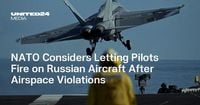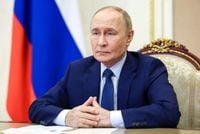NATO is facing a new wave of tension as member states debate how to respond to a surge in Russian provocations along the alliance’s eastern flank. Recent weeks have seen a flurry of mysterious drone sightings, airspace incursions, and airport disruptions across Europe, all of which Western officials increasingly attribute to Moscow’s hybrid warfare campaign. Now, as reported by the Financial Times on October 9, 2025, talks are underway among NATO allies regarding a potential escalation of military measures, including the deployment of armed drones and a possible relaxation of engagement rules for pilots patrolling the border with Russia.
The urgency of these discussions is palpable. According to four NATO officials cited by the Financial Times, the aim is to “raise the cost of Moscow’s gray-zone operations” and bolster deterrence after a string of airspace violations by Russian drones and aircraft. The measures under consideration are bold: arming intelligence-gathering drones that currently operate unarmed, conducting large-scale military exercises along the Russian border—especially in less fortified regions—and even easing the rules of engagement to allow NATO pilots to open fire on Russian aircraft that violate allied airspace.
These proposals, officials say, were first floated by countries bordering Russia, with France and the United Kingdom lending strong support. The initiative has since grown, drawing in a broader swath of the 32-nation alliance as the scale of the threat becomes ever more apparent. The debate comes against the backdrop of several high-profile incidents. On October 3, 2025, Munich International Airport faced two consecutive disruptions, while similar shutdowns hit Oslo and Copenhagen airports in recent weeks. In September, Polish forces shot down several Russian drones that had entered their airspace, and a Russian drone breached Romanian territory, though Bucharest opted not to engage. Perhaps most alarmingly, three Russian MiG-31 fighters entered Estonian airspace for 12 minutes on September 19, prompting Estonia to invoke NATO’s Article 4, which allows for urgent consultations among allies.
Estonian Defense Minister Hanno Pevkur, speaking to the Kyiv Independent, warned, “This is exactly what Russia wants — for us to overreact and then claim that NATO started the war with Russia. You cannot fall into that trap.” His cautionary words highlight the delicate balance NATO must maintain: responding forcefully enough to deter further Russian aggression, but not so aggressively as to risk spiraling into direct conflict with a nuclear-armed adversary.
Despite these concerns, pressure is mounting within the alliance. Some member states, especially those on the front lines, are pushing for a more assertive posture. Others, wary of escalation, urge restraint. As one NATO diplomat told UNN, “These issues are actively being discussed, how best and most effectively to respond to Russia’s actions,” but emphasized that talks remain in the early stages and that “there are no deadlines or commitments to agree on any changes to the strategy.”
At the heart of the debate is the question of rules of engagement. Currently, protocols vary widely among member states. In some countries, fighter pilots must have visual confirmation of a threat before firing, while others permit engagement based on radar data or threat assessment—such as the direction or speed of an intruding aircraft. This lack of consistency, officials say, poses coordination risks during a crisis and has prompted calls for a more unified approach to combat readiness on the alliance’s eastern flank.
“One of the urgent tasks is to optimize the rules of engagement on the eastern flank,” two NATO officials told UNN. The idea is to ensure that pilots have clear, standardized guidelines for responding to potential threats, reducing the risk of hesitation or miscalculation in fast-moving situations.
There’s also the matter of transparency. According to sources cited by the Financial Times, NATO is not obligated to publicly announce any potential policy changes, and the degree of disclosure remains a topic of internal debate. This ambiguity could be strategic, preserving flexibility while keeping Moscow guessing about the alliance’s true intentions.
The recent provocations have not gone unnoticed in European capitals. In Moscow, British, French, and German ambassadors reportedly confronted Russian officials over the incursion of three MiG-31 jets into Estonian airspace. Western diplomats believe the incident was a deliberate move, authorized at the highest levels of the Russian military command. During the talks, a Russian diplomat countered that these violations were a response to Ukrainian strikes in Crimea—strikes that, Moscow insists, would not have been possible without NATO support. Russian officials further suggested that they already consider themselves in confrontation with Western countries, a chilling indication of the Kremlin’s current mindset.
Meanwhile, Ukrainian President Volodymyr Zelensky added another layer of complexity, stating on September 28 that Ukrainian intelligence reports indicate Russia’s so-called “shadow fleet” of oil tankers is being used to “launch and control” drones over European cities. German Chancellor Friedrich Merz echoed these concerns on October 5, asserting that Russia is believed responsible for many of the unidentified drones spotted over German territory.
Beyond NATO, the European Union is also stepping up its response. The European Parliament recently passed a resolution demanding stronger collective action against Russian airspace violations and hybrid warfare threats, explicitly including the right to shoot down airborne intruders deemed hostile. The EU is preparing additional measures, such as travel restrictions for Russian diplomats suspected of espionage and increased funding for drone defense systems.
Matthew Whitaker, the US Ambassador to NATO, underscored the urgency of the moment. “I am working every day with allies to ensure we have the best options in asymmetric… and hybrid warfare,” Whitaker said, according to UNN. He emphasized the importance of “making sure we have enough rungs on the escalation ladder,” signaling that the alliance is preparing for a range of contingencies.
Against this backdrop, NATO has already taken concrete steps. The alliance recently launched Operation Eastern Sentry, a mission designed to strengthen the air defense of frontline states. Emergency talks have been held twice in the past month in response to incidents in Poland and Estonia. Yet, as officials caution, the path forward remains uncertain. There are no firm deadlines or commitments, and any changes to strategy may not be made public.
As the alliance weighs its options, one thing is clear: the security environment in Europe is shifting rapidly. The challenge for NATO is to adapt quickly and decisively—without playing into Moscow’s hands or risking unintended escalation. The coming weeks and months will reveal whether the alliance can thread this needle, maintaining both unity and deterrence in the face of mounting Russian provocations.

